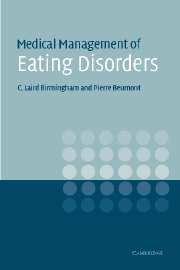Book contents
- Frontmatter
- Contents
- List of color plates
- List of contributors
- List of abbreviations
- Introduction
- PART I THE MEDICAL PERSPECTIVE
- 1 Definitions and epidemiology
- 2 The behavioral disorders
- 3 History, examination, and investigations
- 4 Medical manifestations by system
- 5 The clinician's response to common physical complaints
- PART II TREATMENT
- PART III SPECIAL ISSUES
- PART IV THE PSYCHIATRIC AND PSYCHOLOGICAL PERSPECTIVE
- PART V AREAS OF SPECIAL INTEREST
- Bibliography
- Index
- Plate section
3 - History, examination, and investigations
Published online by Cambridge University Press: 18 December 2009
- Frontmatter
- Contents
- List of color plates
- List of contributors
- List of abbreviations
- Introduction
- PART I THE MEDICAL PERSPECTIVE
- 1 Definitions and epidemiology
- 2 The behavioral disorders
- 3 History, examination, and investigations
- 4 Medical manifestations by system
- 5 The clinician's response to common physical complaints
- PART II TREATMENT
- PART III SPECIAL ISSUES
- PART IV THE PSYCHIATRIC AND PSYCHOLOGICAL PERSPECTIVE
- PART V AREAS OF SPECIAL INTEREST
- Bibliography
- Index
- Plate section
Summary
Special considerations for history taking in eating disorder patients
Leave your office to meet the patient and observe their behavior with those who have accompanied them. Note their state of affect and ability to walk, then gait, weakness, and unsteadiness.
Certain elements of the history, such as those related to abuse or sexual issues, may best be left to a subsequent interview when rapport has been developed.
Instruct the patient to change in a private area, to keep on their underwear, and to wear the gown open to the back. Examining the patient while fully dressed may lead to failure to observe the degree of emaciation and other physical signs. It is preferable to perform the physical examination in the presence of a female trusted by the patient. Do not do rectal, pelvic, or breast examination as part of an eating disorder assessment physical examination.
Mental status examination
General appearance and behavior
Does the patient appear physically unwell, anxious, or depressed? Is he or she emaciated, or are they wearing clothes that obscure their figure? Is the patient restless? Many anorexic patients are unable to sit still or even sit, even when asked to do so, and continually jiggle their feet.
Speech
Is the patient communicative, or do they answer only briefly and reluctantly. Does the patient set out to justify their reasons for dieting? Do they avoid eye contact when asked potentially confrontational questions about eating, exercise, vomiting, or laxative abuse?
- Type
- Chapter
- Information
- Medical Management of Eating DisordersA Practical Handbook for Healthcare Professionals, pp. 24 - 47Publisher: Cambridge University PressPrint publication year: 2004



